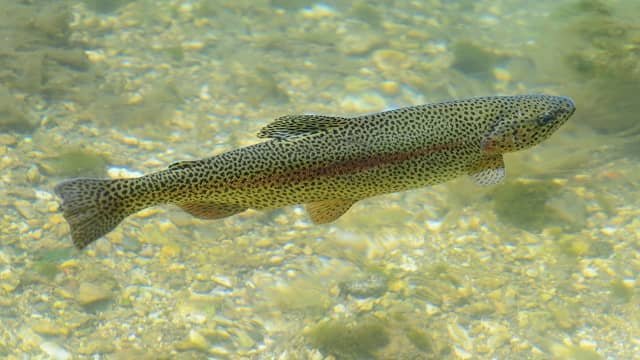
Carotenoid-rich additives are widely used in fish diets due to their easy availability from various plant sources. These supplements offer several health benefits and functions across a variety of species.
In the dynamic world of aquaculture, a recent study has delved into the potential dietary effects of Capsicum annuum oleoresin (CAO) on rainbow trout.
A team of researchers from Çanakkale Onsekiz Mart University, Kastamonu University, and Alexandria University evaluated the influences of supplementing diets with CAO, a dietary carotenoid, on the growth and intestinal health (histology, morphometry, and intestinal microbial communities) of rainbow trout. Additionally, they assessed the impacts on the sensory characteristics of trout fillets.
The study findings provide valuable information on optimizing rainbow trout diets for both improved growth and overall health.
Plant-Origin Oleoresins
Researchers state that oleoresins are oil-soluble semi-solid extracts originating from solvent extraction of finely ground powder from spices such as pepper (paprika), cinnamon bark, fenugreek, ginger, marjoram, nutmeg, parsley, white or black pepper, thyme, or turmeric.
Various studies in aquaculture species have reported that dietary supplementation with natural oleoresins (paprika, turmeric, and chlorophyll) improved skin pigmentation without negative impacts on the body condition and digestive functions of ornamental clownfish.
Optimizing Growth with CAO
Capsicum annuum oleoresin (CAO) is a natural plant extract rich in carotenoids and obtained from different varieties of C. annuum. The active ingredients in CAO are capsaicinoids, with capsaicin being the main predominant component.
In the 30-day study, researchers supplemented rainbow trout diets with varying levels of CAO (0.0-Control, 7.0 g kg-1 C7, 14.0 g kg-1 -C14, 21.0 g kg-1-C21, and 28.0 g kg-1-C28). Surprisingly, maximum growth was achieved in the C7 and C14 groups, demonstrating the positive impact of CAO on growth parameters. However, other CAO groups showed growth similar to the control group.
Stay Always Informed
Join our communities to instantly receive the most important news, reports, and analysis from the aquaculture industry.
According to the study results, the enhanced growth in the C7 and C14 groups could be attributed to the growth-promoting functions of the carotenoids present in the pepper-supplemented diets provided to rainbow trout.
“These findings suggest that dietary supplementation doses exceeding 14 g kg-1 are not recommended due to their negative impacts on growth rates,” report the scientists.
Body Composition Benefits
Results indicated significant increases in dry matter and crude lipid contents in all CAO groups compared to the control. This suggests that CAO supplementation positively influences rainbow trout’s body composition, potentially enhancing its nutritional value.
Intestinal Microbiome and Histological Changes
While prevalent bacteria at the genus level in trout intestinal samples showed no significant changes, CAO in the diet induced significant alterations in intestinal histological structure.
According to the study, “Faecalibacterium, Ruminococcus, Lactobacillus, and Blautia were the most prevalent bacteria at the genus level. Their relative abundances showed no significant differences among the tested groups. This means that dietary CAO did not alter microbial communities in the trout’s intestine.“
The increased number of goblet cells observed in CAO-supplied groups indicates a positive impact on intestinal health. However, deformations in the epithelium of intestinal villi, particularly notable in the C28 group, suggest a nuanced relationship with increased CAO levels.
Sensory Attributes and Culinary Delight
A novel aspect of the study explored the sensory attributes of cooked trout fillets. Interestingly, the pungent smell and taste of pepper were evident in the C14 group and increased with higher CAO levels. This nuanced finding implies that CAO can contribute to a distinctive culinary experience without compromising sensory appeal.
Conclusion
In an innovative revelation, this study demonstrates that CAO in diets at levels between 7 and 14 g kg-1 can significantly improve rainbow trout growth. The positive impact on body composition and intestinal health adds more weight to the potential benefits of CAO supplementation in rainbow trout diets.
“However, the pungent smell and taste of pepper began to be noticeable in the C14 group and subsequently increased with CAO dietary doses. Therefore, supplementation doses exceeding 14 g kg-1 are not recommended due to their negative impacts on growth rates, intestinal barrier integrity, and intestinal health,” concluded the scientists.
It is noteworthy that the study reveals the sensory characteristics of cooked trout remain intact, even with CAO supplementation up to 14 g kg-1, providing a holistic approach to optimizing rainbow trout diets for both growth and culinary satisfaction.
The study was funded under the Scientific Research Projects (COMU-BAP) of Çanakkale Onsekiz Mart University, Çanakkale, Turkey.
Contact
Sevdan Yilmaz
Department of Aquaculture, Faculty of Marine Sciences and Technol
Çanakkale Onsekiz Mart University
Çanakkale 17100, Türkiye.
Email: sevdanyilmaz@comu.edu.tr
Hany M. R. Abdel-Latif
Department of Poultry and Fish Diseases, Faculty of Veterinary Medicine
Alexandria University
Alexandria 22758, Egypt.
Email: hmhany@alexu.edu.eg
Reference (open access)
Yilmaz, S., Çelik, E. Ş., Ergün, S., Gürkan, M., Kesbic, F. I., & Abdel-Latif, H. M. R. (2023). The effects of Capsicum annuum oleoresin, as a dietary carotenoid, on growth, gut microbiome, intestinal histomorphometry, and sensory characteristics of Oncorhynchus mykiss. Journal of the World Aquaculture Society, 1–20. https://doi.org/10.1111/jwas.13039
Editor at the digital magazine AquaHoy. He holds a degree in Aquaculture Biology from the National University of Santa (UNS) and a Master’s degree in Science and Innovation Management from the Polytechnic University of Valencia, with postgraduate diplomas in Business Innovation and Innovation Management. He possesses extensive experience in the aquaculture and fisheries sector, having led the Fisheries Innovation Unit of the National Program for Innovation in Fisheries and Aquaculture (PNIPA). He has served as a senior consultant in technology watch, an innovation project formulator and advisor, and a lecturer at UNS. He is a member of the Peruvian College of Biologists and was recognized by the World Aquaculture Society (WAS) in 2016 for his contribution to aquaculture.




